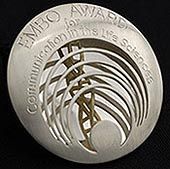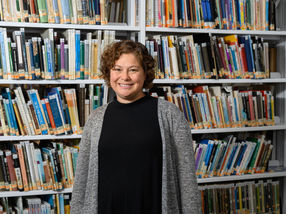Francis Harry Compton Crick 1916-2004
Advertisement
La Jolla, CA. - Francis Harry Compton Crick, co-discoverer of the double helical genetic blueprint of life known commonly as DNA, died yesterday. He was 88 years old and a resident of La Jolla, Calif.
For his work, Crick - a distinguished research professor and former president of the Salk Institute for Biological studies -- was awarded the Nobel Prize in Physiology or Medicine in 1962, along with his colleagues James D. Watson and Maurice Wilkins.
The impact of their discovery is recognized by many as one of the most significant of the 20th century and affects practically every scientific discipline in the life sciences.
"Francis Crick will be remembered as one of the most brilliant and influential scientists of all time." said Richard A. Murphy, the Salk Institute's president and chief executive officer. "He will be missed as a gentleman, a role model, and a person who has contributed so much to our understanding of biology and the health of mankind. For those of us privileged to know him at Salk, he will also be remembered as a dear friend. "
"We were honored to have him with us for so many years and will miss him tremendously."
To those who knew him best, it was Crick's insatiable curiosity about life and the creativity of his mind that set up him apart from others. In recent years, he put these qualities to work in an attempt to find the neural correlate of consciousness, a problem he defined as the search for the link between the mind and the brain. Although he was a pathfinder in this young field, he knew that it would take younger minds than his to one day untangle the myriad mysteries of the human brain.
When asked what he hoped his future contributions would be, he said, "To excite younger people to study the problem of consciousness."
Said Christof Koch, a professor of neuroscience at the California Institute of Technology and one of Crick's collaborators: "Francis delighted in playing the important role of devil's advocate for several generations of young researchers."
Born in Northampton, England, on June 8, 1916, Francis Crick showed an early curiosity for all things - but for science in particular. The young Crick attended Northampton Grammar School and later the Mill Hill School in North London, where he received a basic education in chemistry, physics and mathematics.
To help answer his many questions, his parents - Harry Crick and Annie Elizabeth Wilkins - bought their young son a Children's Encyclopedia that covered a vast range of topics, from history and music to science. But the subjects that intrigued him the most centered on things like the nature of the galaxy, chemistry and how things were made of atoms.
Later, Crick would study physics at University College in London, where he received a bachelor of science degree in1937. He began studying for his Ph.D., but this work was interrupted by the outbreak of war in 1939. During World War II, he worked as a scientist for the British Admiralty, helping to design magnetic and acoustic mines.
When the war ended, however, Crick found himself less interested in physics and somewhat vague about what he wanted to do with his future.
"I still didn't know much about anything so I could go into whatever I wanted," Dr. Crick recalled in 1997 during an honors seminar lecture at Rutgers University.
"I used what I call the 'Gossip Test' to decide what I wanted to do," he said. "The gossip test is simply that whatever you find yourself gossiping about is what you're really interested in. I had found that my two main interests which I discussed the most were what today would be called molecular biology, what I referred to as the borderline between living and the nonliving, and the workings of the brain."
In 1947, Crick left the Admiralty and turned to studies in biological research at the Strangeways Laboratory in Cambridge, supported by a studentship from the Medical Research Council and some financial help from his family. At that time, Crick knew little biology and practically no organic chemistry or crystallography; however, he soon went beyond the fundamentals in each of these areas.
In 1949, Crick joined the Medical Research Council Unit as a laboratory scientist in the Cavendish Laboratory at Cambridge University. During the next few years Crick, working with colleagues at the lab, worked out the general theory of x-ray diffraction by a helix.
A critical influence in Crick's career was his friendship, beginning in 1951, with James Watson, then a brash, young American on a postdoctoral fellowship in genetics. The duo immediately struck up an intense collaboration, based on a conviction that DNA, not proteins, was the critical factor for passing on genetic information from generation to generation.
"It was obvious that I knew more about x-rays and structures than Jim did and he had more background in biological things which I'd only toughly taught myself," he said. "So you might have guessed that I did the structural part and he did the more biological aspect.
"That really wasn't true. For example, Watson discovered exactly how the base pairs went together, which is structural. He made that discovery."
Their work led in 1953 to the proposal of the double-helical structure for DNA and the replication scheme. Crick and Watson subsequently suggested a general theory for the structure of small viruses. Later, in research with Sydney Brenner, professor of genetic medicine at the University of Cambridge, Crick developed ideas about protein synthesis ("the adaptor hypothesis") and the genetic code.
By 1966, sensing that the foundation for molecular biology was adequately set, Crick turned his attention to embryology. Then, in 1976, he joined the Salk Institute for a sabbatical year from the Medical Research Council. The following year, after 30 years and 87 scientific papers, he decided to make a permanent switch to the Salk, where he pursued his interests in understanding the brain and the nature of consciousness.
In the epilogue of his book "What Mad Pursuit: A Personal View of Scientific Discovery," Crick says that the brain sciences today are reminiscent of the state of molecular biology and embryology in the 1920s and 1930s.
"The brain sciences still have a very long way to go," he writes. "But the fascination of the subject and the importance of the answers will inevitably carry it forward. It is essential to understand our brains in some details if we are to assess correctly our place in this vast and complicated universe we see all around us."
Aside from more than 130 published papers in his life, Crick also wrote several books including "Molecules and Men" (1966), "Life Itself" (1981), and "The Astonishing Hypothesis, The Scientific Search for the Soul" (1994).
In addition to the Nobel Prize, his honors included the Lasker Award, the Award of Merit from the Gairdner Foundation, and the Prix Charles Leopold Meyer of the French Academy of Sciences. He was a member of the U.S. National Academy of Sciences, the Royal Society, the French Academy of Sciences and the Irish Academy.
Crick is survived by his wife, artist Odile Speed; two daughters by his marriage, Gabrielle A. Crick and Jacqueline M-T Nichols, both residing in England; a son by a previous marriage, Michael F.C. Crick of Seattle, and four grandchildren. Crick's first wife is Ruth Doreen Dodd. They were divorced in 1947.
























































